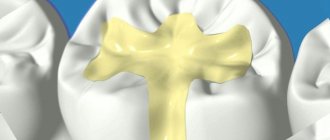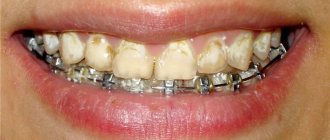10.01.2020
The quality of health today depends not only on financial capabilities, but also on a banal misunderstanding of the doctor’s wording. Some new-age medical terms confuse patients when they need to make a quick decision. Especially often a person hesitates in the dentist’s chair when the doctor offers to choose a filling. How significant is the difference between a light filling and a regular filling? Which one will last longer?
Conventional chemical
The main difference between a simple (chemical) filling and a light filling is how they harden. A regular filling becomes hard due to a chemical reaction that occurs when different types of filling material are mixed. The result is a consistency with the required density and elasticity.
Dentists typically use two types of conventional chemical fillings:
- Composite - it contains several different chemical ingredients, which, when hardened, can differ significantly from the natural color of tooth enamel. The material hardens evenly, but does not last long - usually about 2 years.
- Glass ionomer - contains a special liquid and powder, which are mixed in the required proportion.
The composition hardens due to an acid reaction. Dentists can add additional components to this mixture as needed. Attention! Glass ionomer filling is good because it has the ability to release fluoride, which serves as a preventive measure against the re-development of caries.
What you should (not) pay for at the doctor: 8 non-obvious situations
It is legal? No. “Light-curing fillings have always been a stumbling block in dentistry. They are considered the strongest and most stable and were often imposed on patients as paid services, explains Alexey Starchenko. “However, from January 1, 2018, light-curing fillings are included in the State Guarantee Program and must be installed free of charge to citizens.” Only in some situations, for medical reasons, may it be necessary to install a different, non-light-curing type of filling - then this must be justified and recorded in the card.
It is legal? No. The deadlines for the provision of medical services are clearly stated in the SGBP. Diagnostic instrumental studies (X-ray, mammography, ultrasound) and laboratory tests must be carried out a maximum of 14 calendar days from the date of appointment. You can wait no more than 30 calendar days for CT and MRI.
Suppose you want to see a pulmonologist (oncologist, endocrinologist, epileptologist or other specialist), but the therapist does not give a referral because he sees no reason. Essentially, this means that you will have to pay for a consultation with a specialized doctor.
A trip to the local clinic is not the most entertaining activity in the world anyway. And if you suddenly ask for money for a medical service that you expected to receive for free, your mood completely deteriorates. To pay or not? Let's look at the most typical situations.
“If you are sure that your attending physician is wrong with the diagnosis and you really need the advice of a specialized specialist, you can write a statement of disagreement with the actions of the doctor and with the diagnosis he made addressed to the head of the clinic or to the medical commission. The period for consideration of the application is 30 days,” says Natalya Ostapenko.
Light
In the professional language of dentists, there are several variations of names for this filling: light, light-composite, gel filling. These terms have a direct connection with the method of curing the filling material. The light seal hardens when exposed to ultraviolet radiation from a special lamp. The hardened material looks natural and aesthetically pleasing. It fits tightly to the edges of the teeth and guarantees long service life.
The difference between light and conventional fillings also lies in the speed at which the material hardens. The components of the light filling polymerize under ultraviolet radiation and harden much faster than the ingredients of the chemical composition. It is very important for a dentist to do everything in 40 seconds. Otherwise, the filling material will begin to crack, since during the hardening process the dental canals are subjected to enormous stress from the inside. Dentists try to avoid this complication. To reduce the risk of cracks, filling material is applied to the canals in stages, in layers.
Attention! The main advantage of a light-curing filling is the ability to restore broken and completely destroyed teeth. The dentist can restore the natural shape of the tooth, its relief, and select the desired shade for full compatibility with the natural color of the enamel.
The light filling literally returns to the patient what seemed hopelessly lost - a realistic tooth and a smile without complexes. But there is also a minus. If the carious cavity is very deep, the dentist will not be able to perform light polymerization and will place a conventional chemical filling in the tooth.
The dental clinic offers to install a paid filling
The timing of diagnostic instrumental (radiographic studies, ultrasound studies) and laboratory tests in the provision of primary health care should not exceed 14 (in Moscow 10) working days from the date of appointment. The timing of computed tomography (including single-photon emission computed tomography), magnetic resonance imaging and angiography in the provision of primary health care should not exceed 30 (in Moscow 26) working days from the date of appointment.
This means that if a citizen develops a disease of the oral cavity, salivary glands and jaw, he (she) has the right to receive the necessary dental care (in a clinic, hospital) from a medical organization at the district, regional, and, if there are medical indications, at the federal level. free of charge.
First, contact the administrator of the medical organization (chief physician, deputy chief physician, head of department) with a request to explain the reason for the refusal or request for payment. In most cases, the problem is resolved on the spot. If the administrator refuses to help, contact your medical insurance company (name, phone number, address, email address is on your compulsory medical insurance policy). Insurance company employees will provide you with the necessary advice and, if necessary, take measures to solve the problem.
How much does a light seal cost?
Prices for dental work in reliable clinics are based on how complicated (or neglected) the tooth is. The cost of a light filling also depends on the condition of the tooth - the depth of the carious cavity, the degree of destruction of the walls, and the health of the canals. The more work the dentist requires, the higher the price will be. But the financial side of the issue may depend not only on the illness that the patient brought with him. If the clinic has a high status and brilliant authority, the price for a light filling may be too high. This is how reputable clinics maintain their status. Conversely, if a dental office has opened recently, and its main task is to attract customers, the price tags for services may be low.
In general, the cost of a light-curing filling ranges from 2,000 to 15,000 rubles. But higher prices are also possible (as a rule, in cases where the tooth is too neglected). Filling the front teeth is always more expensive than the back teeth, because the smile area requires the highest quality and most expensive materials. The variety of dental clinics today is too great to not know where to go. Each patient decides for himself what to choose: either too expensive treatment, but with a guarantee of quality, or hope for a successful result and significant savings. There is a third option: price and quality in equal proportions - you need to choose this one. As a rule, many patients rely on reviews from friends and acquaintances, and on this basis they choose a clinic and a dentist. The most important thing is not to forget that a healthy smile is priceless.
About paid fillings, policies and quality of treatment
“I came with a compulsory medical insurance policy to see a dentist. The doctor performed certain manipulations on me and asked: “Which filling should I get - a simple one or a good one?” At the same time, she noticed that I had to pay for a good filling. Tell me, what is the difference between a good filling and a simple one? And was the money taken from me legally?”
- We can, and we will help. We are often contacted by residents of different areas of the region who cannot urgently undergo some kind of examination. This could be an ultrasound, biopsy, computed tomography. We immediately contact the medical organization and check whether the patient has been placed on the waiting list for two or three months in advance. If you have heart pain and an ultrasound needs to be done now to establish a diagnosis and prescribe the correct treatment, then the doctor is obliged to organize an extraordinary examination. When the examination is carried out as planned, you can wait. The decision must be made by the doctor who is observing you. If, for health reasons, you cannot wait three months for an ultrasound scan, and the clinic does not cooperate, then contact the insurance company.
— If your problem remains relevant today, please come to the insurance company, write a statement, and we will sort it out. If you are wrongfully denied surgical intervention, then we will assist in organizing surgical treatment for your spouse. Our address: Blagoveshchensk, st. Krasnoarmeyskaya, 110.
JSC MSK Dalmedstrakh ranks first among insurance companies in the Amur region in terms of territorial coverage - its representatives work in all cities and districts of the region. The company has effective measures to protect the rights of insured citizens and resolve difficult situations that arise in medical institutions.
“I heard that we will soon have plastic policies that will be valid throughout Russia. If you are in another region, you can contact a medical organization with such a policy, and you will be provided with full medical care. When will you start issuing plastic?
Benefits of light filling
Light polymerization fillings are more modern, which means they are created using improved technology, which distinguishes this material from chemical ones. What are the advantages of a light filling over a regular one?
- High plasticity. The dentist can safely form the crown of the tooth without fear that the material will harden ahead of time and something will be left unfinished. The light composition hardens only under targeted exposure to an ultraviolet lamp.
- Softness of the material. The special structure of the composition allows you to qualitatively fill all the anatomical convolutions in the tooth cavity and adhere tightly to the edges. Fits perfectly on any teeth: front and back.
- Hypoallergenic, non-toxic composition. This filling can be placed during pregnancy and the lactation period - it is completely harmless to the body.
- Wide range of shades. The dentist can choose the natural color of the enamel for any patient, and this is very important when filling the front teeth.
- Compliance of the material. It is easy and quick to sand and polish.
- Rapid maturation of the material. After installing the light-curing composite, the patient can eat food almost immediately without fear of escaping.
- Less painful tooth preparation. The patient will not suffer much from contact with the drill.
- Wear resistance. A light seal can serve a person for more than 5 years.
When treating a chewing tooth that is not too neglected, the patient, as a rule, can save on filling material and choose a chemical one. But when it comes to the smile itself, then you simply cannot do without the use of a light filling with its significant advantages.
Category Dental filling Posted by Mister stomatolog
Kinds
Various types of fillings are used to repair holes and cracks. Their composition, purpose and service life differ.
By material
Patients of modern dental clinics can independently choose the compositions that the doctor will use for treatment or restoration. Filling material differs in strength, consistency, and hardening time. Which one to choose depends on the problem the person is addressing.
Cement
Just a few decades ago, this material had no alternative competitors. It was possible to place a cement filling on a tooth in any clinic, and its cost was minimal. They were made on the basis of phosphate and silicate powders, which hardened under the influence of a chemical reaction when mixed with liquid.
The dentist needs to work with such material quickly, and after filling the patient should not consume food or water for 2 hours. Advanced clinics refuse cement fillings - the material is characterized by low adhesion, even under a technically correctly installed filling, food debris can get in, and carious processes can continue to develop underneath it.
Plastic
A damaged tooth without a filling continues to rapidly deteriorate, posing a danger to neighboring units and the oral cavity. Some dentists suggest using plastic to eliminate the problem. Such fillings are characterized by rapid hardening, excellent strength, and chemical resistance.
However, it is worth noting the disadvantages of the material. Over time, the plastic filling decreases in size and sags, and may be irreversibly stained by bright drinks. This will lead to the need to quickly replace the insert, which is associated with additional financial expenses.
Note! Plastic fillings are slightly toxic.
Composite light-curing
Photopolymer fillings are ideal for dental treatment. It has a paste-like consistency, is easy for a doctor to work with, and the material hardens under the influence of a special ultraviolet lamp. A variety of shades allows you to choose the one that will best match the tone of your native enamel. Thanks to this, it is from photopolymer that fillings are placed on the front teeth. To add shine, the composite is sanded with fine abrasive attachments after installation.
Ceramic
In terms of its properties, ceramics are closest to natural enamel. It is not surprising that this material is often used for fillings. Dentists make special ceramic inlays based on an impression of a pre-treated molar. They completely replicate the anatomical features of the tooth, and after installation, the chewing load will be evenly distributed over the entire surface. Over time, ceramics do not change color, do not wear off, and do not shrink. The only disadvantage for the patient is how much a filling costs for a bad tooth.
Glass ionomer
This type of cement is often used in complex therapy against caries in children. They contain fluoride, which prevents recurrent caries. Since the material is quite fragile, a composite is usually applied on top of it - it is more aesthetically pleasing, resistant to abrasion and not subject to shrinkage.
By service life
Depending on the problem with the tooth, dentists offer the installation of 2 types of fillings.
Temporary
It is used for diagnostic purposes when the dentist needs to observe how a tooth responds to treatment. Installing a temporary tooth filling prevents medications from escaping and moisture and pieces of food from entering the open cavity. After a couple of days or months, the material is removed and the teeth are treated further.
Constant
This is a permanent element of the tooth. Installed for several years, good fillings made from quality materials can last up to 10 years without the need for replacement.
How teeth are filled
If caries has appeared, a piece of enamel has broken off, or an old filling has fallen out of a tooth, then a trip to the dentist is mandatory! The availability of modern equipment, fast-acting anesthetics and good materials makes the treatment completely painless and comfortable for the patient. Before filling, the doctor will assess the condition of the oral cavity, remove carious stains, and, if necessary, carry out additional treatment for pulpitis or periodontitis.
The filling is placed according to a single scheme:
- the cavity is disinfected;
- the cleaned cavity is dried;
- Antimicrobial pads are placed inside if necessary;
- the prepared cavity is filled with a filling mixture, it is formed and illuminated with a polymerization lamp;
- the frozen mass is polished.
Important! If the filling is placed correctly, then the patient can comfortably close his jaws.
The nuances of treating anterior teeth
Restoration of anterior teeth requires a special approach. There are special requirements for the material that is used to restore the surface of the visible part of the dentition. It must be immune to temperature changes, biocompatible with native enamel, durable, and able to withstand constant chewing loads. After cosmetic repairs with photopolymer or light fillings, the front teeth will look beautiful and healthy.
What to do with a wisdom tooth?
Eights today are considered to be a rudiment. If holes appear in these molars, then not every doctor undertakes to save the dental unit. Most often, they resort to extraction because it is unknown how the tooth will behave after treatment. Wisdom teeth are filled only in certain cases:
- if the nearest tooth is destroyed and the figure eight can be used to install a prosthesis;
- in the presence of an antagonist;
- with severe damage to the integrity of the dentition.
The procedure for treating wisdom teeth is no different from the standard one.
How does the filling installation process work?
Filling is carried out in several stages.
- Examination and assessment of the condition of the tooth. The doctor determines the size of the lesion and finds out whether the inflammation has spread to the pulp.
- Anesthesia. Tooth filling is carried out under local anesthesia: one or two injections freeze the gum around the diseased tooth and the patient does not feel pain during further manipulations.
- Tooth preparation. The doctor drills the tooth, removing the affected tissue. At the ViDentis clinic, specialists work in binoculars - special microscope glasses in which the smallest details are visible. This allows you to preserve healthy tissue as much as possible, drilling only the areas affected by caries.
- Application of filling material. We use a layer-by-layer technique of applying polymer to the tooth and drying each layer with ultraviolet light. This allows you to achieve high strength and excellent appearance. Aesthetic restoration is also carried out in the same way, when, with the help of filling, for example, a chipped cutting edge of the front teeth is restored. This is the most reliable way to place a filling, and the cost of treatment does not increase.
- Turning and polishing of the filling. To ensure that the filling feels comfortable in the mouth, the doctor grinds off excess material, and so that plaque does not “get stuck” on the surface of the filling, it is polished.
Requirements for fillings
The requirements for an ideal filling material were formulated by dentists back in the 19th century, and, with some amendments and additions, remain relevant today. A good restoration material should:
- Have good adhesion (sticking) to tooth tissues.
- Possess chemical resistance and do not deteriorate from exposure to saliva, food, or dentinal fluid.
- Ensure long-term preservation of the tooth shape and prevent shrinkage over time.
- Facilitate the doctor’s work due to the following properties: plasticity, ease of insertion into the cavity, lack of sticking to instruments, length of “working time”.
- Characterized by high biocompatibility with hard dental tissues, oral mucosa and the body as a whole.
- Have high mechanical strength, withstand loads during chewing (according to various sources, incisors experience chewing pressure of 7-23 kg, molars - up to 22 kg, wisdom teeth - up to 60 kg).
- To be environmentally safe, not to harm the health of not only the patient, but also the medical staff.
- Have low thermal conductivity to avoid pulp sensitivity to cold or hot food.
- Have a coefficient of thermal expansion (CTE) similar to the CTE of dental tissues.
- Have an anti-caries effect on the tissues bordering the filling.
- Have a radiopacity no lower than that of the tooth.
- Does not require special storage conditions, has a long shelf life.
The dental clinic offers to install a paid filling
treatment of root canals of teeth: treatment of root canals using NITI rotating machine instruments, filling of root canals using thermoplastic gutta-percha and imported pastes, removal of foreign bodies from root canals;
prevention of dental diseases: preventive cleaning, removal of dental plaque using an ultrasonic device, removal of age spots, plaque, coating with imported fluoride-containing preparations, deep fluoridation of teeth, teeth whitening;










